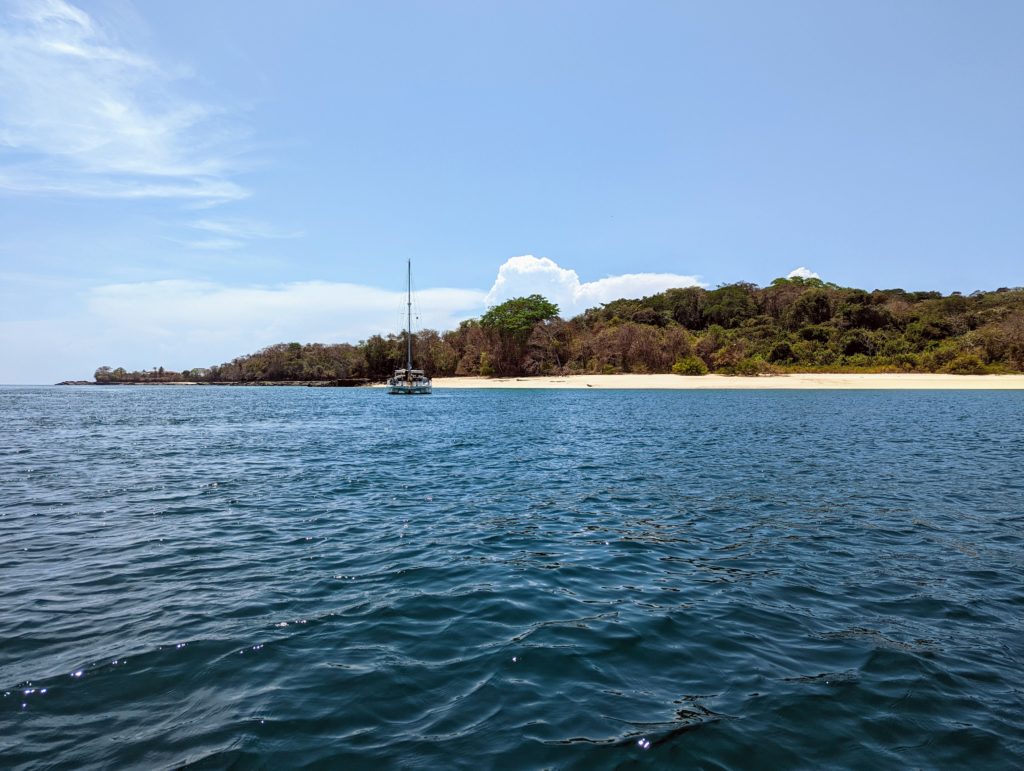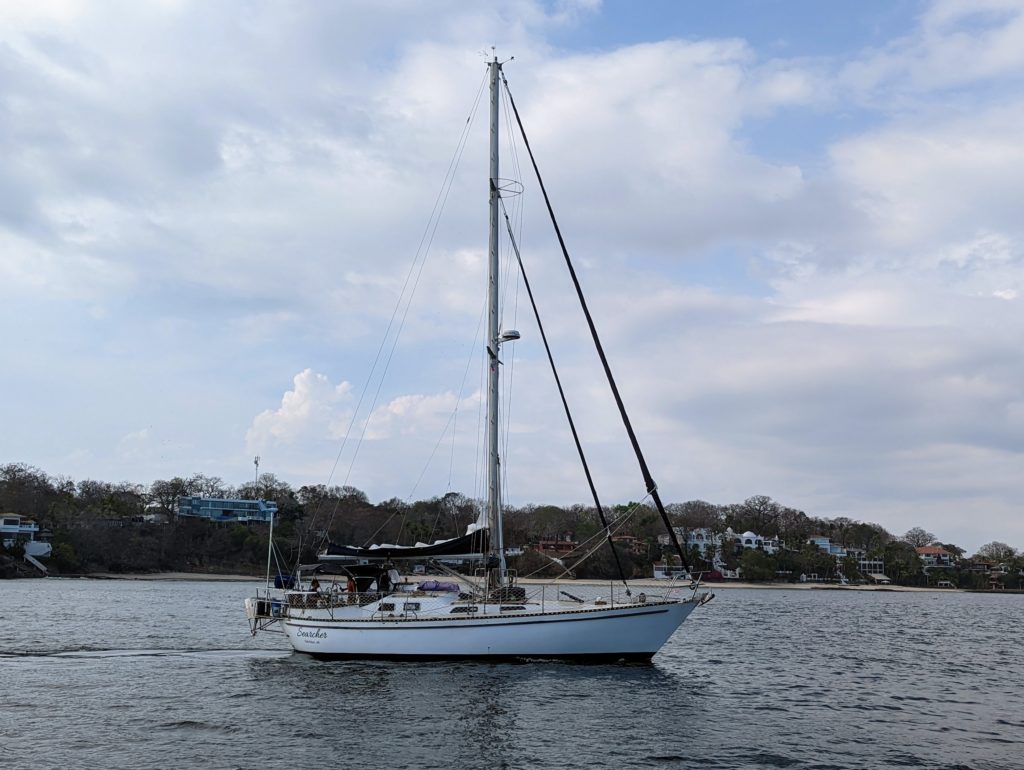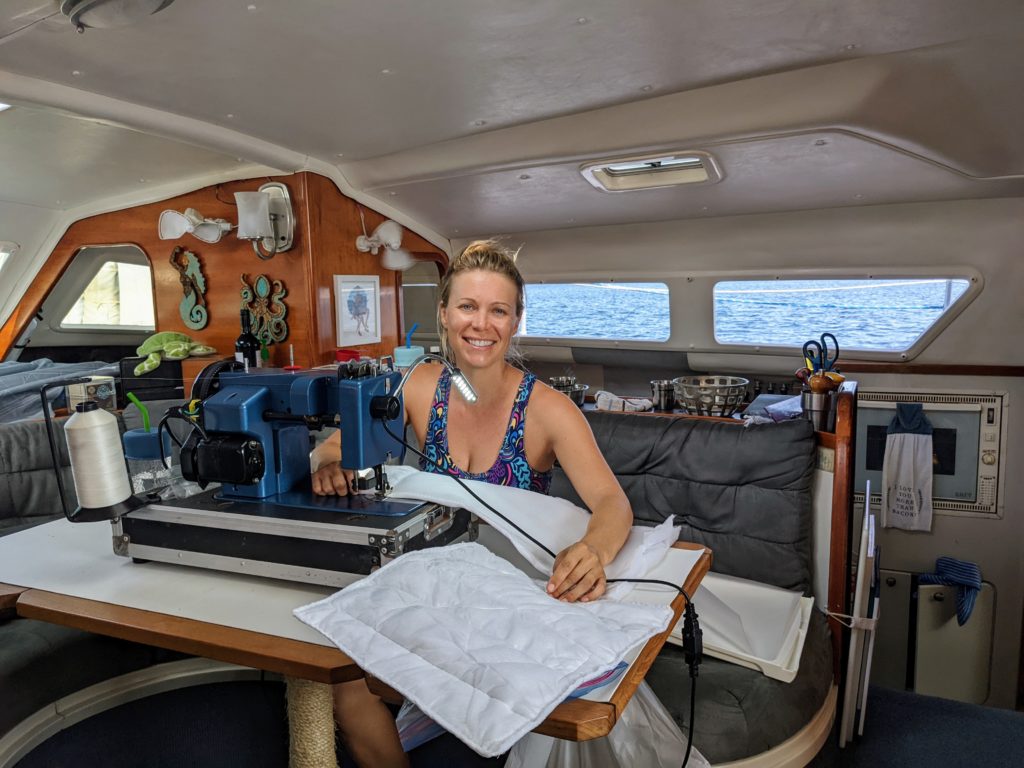We just crossed the Pacific, but we didn’t really get through the Panama story before we left. Here’s the start of that story.
We “sailed” out of La Playita anchorage in the early morning, using the “backup sail” (aka engine) in the dead air. We’d hoped for a little wind, but never saw more than six knots, fortunately angled enough that we didn’t spend the whole trip stewing in our own exhaust fumes. At the time, we thought we were saying goodbye to the American continent for a while, so we took parting pictures.




Our path quickly left the shipping channel, so despite being right next to the Panama canal we saw very few boats. Between this and the dead flat water, the boat mostly managed herself, leaving us to work on organizing our new fresh provisions. After a morning nap to recover from the previous night’s musical sleep-disruptions, Jazz individually vaselined and saran-wrapped all the eggs, and packed them into one of our crates for easy flipping. The coatings are supposed to inhibit bacterial growth, and supposedly flipping the eggs every day or so prevents the yolks from attaching to the sides of the shell, which also tends to cause spoilage. We ended up absolutely hating the vaseline.


We arrived in Las Perlas and dropped anchor in a dead calm bay by Isla Pacheca, between a pristine beach and a thick, gross garbage line. We figure the beach was clean because it disappears completely at high water. We watched a huge colony of Frigate birds and pelicans loop from the trees to the water and back, and we started the process of bleach-dipping and drying all the veggies we’d bought.






Overnight the wind picked up a little, and our smooth flat anchorage became painfully rolly, which we could absolutely have predicted if we had looked at a weather forecast and a map. We took it as a reminder that we are out of the habit, and moved the boat two islands south in the morning. Along the way, we were visited by several big flocks of migrating birds.



We anchored between Chapera and Mogo Mogo, which are apparently where the Survivor series was shot.



It’s a lovely place, but overnight we were swarmed by mosquitoes, and we decided that one day here would be quite enough, thanks very much. Plus, the cell signal was pretty bad, and we still had some paperwork to exchange with the Polynesian biosecurity department. So in the morning, Andrew took a swim to give Villa’s hull a cleaning. It turned out that the waterline was the worst of it; aside from a couple of isolated barnacles, her new paint is still doing its job. But that’s where the mosquitoes from last night were hiding.

While he scrubbed, Jazz went through our ditch bag, making sure that everything in there is still in good condition, changing batteries and silica packets. She also packed the secondary ditch bag of things we use in normal shore life but wouldn’t want to lose, like passports, wedding rings, and the portable radio. We wouldn’t want to lose the cat, either, so we checked to see that his life preserver still fit.




With that done, we took a walk on the very lovely beach at Isla Chapera…




and then motored one island north to the more populated Contadora, watching rays jump in various distant spots through the whole hour-long motor. There, we said goodbye to Searcher, another boat leaving for the crossing, thinking that we would be maybe a day behind them when we finished getting Jazz’s audiobook downloads finished.



In the morning, we got a closer look at the jumping rays. Spinetailed devil rays, we think?




And we tried to get a Digicel signal to download some audiobooks for the trip, but were stymied, so we went into shore. With 16 foot tides, beaching the dinghy for long periods isn’t advisable, so we ponied up the exorbitant $30 day rate for the floating ferry/dinghy dock. (Only open until 5pm, so it’s not as if we could use it to go to shore for dinner! Crazy.) We found a German restaurant with wifi, but speeds were not great, and we walked back to the dinghy with only a few more books and a determination to get going. At least we were able to drop off a “last” bag of garbage, and see some wildlife.
On the way in, we stopped by another boat that had just arrived, and asked if they wanted any garbage brought in. And that’s how we met Acushnet, two other younger boaters who had just left Panama and were staging for the big crossing.





We were making our final engine checks when disaster revealed itself. Our alternator had been vibrating funny when we motored up to Contadora, and we figured the belt needed adjusting. But when we looked, we found the belt improbably loose, and a little more inspection revealed that the mounting bracket had sheared clean off.




Needless to say, we were not happy about this. But at least we had an existing relationship with a Yanmar dealer/mechanic, and were able to talk through the problem and identify a root cause: our engine feet had outlived their lifespans, and were not properly damping vibration. We would have to return to Panama. We were not happy, to put it mildly. Acushnet kindly invited us over for a consolatory dinner, and let us vent.
Before we could head back ourselves, we would have to send the bracket to Panama on the ferry, because without a way to mount the alternator we couldn’t run the motor, and we had no wind for sailing. So Andrew dropped Jazz on the beach. (Why not just go straight to the ferry dock? Because they wanted another $30 day pass just for a drop-off.) Jazz bounced between several inescapably helpful and confidently patronizing people before managing to send the package. Then Andrew came to meet her and they had a drink and a walk, watching the Dinkus lest the rising tide sweep him off his perilous (but free) beach landing spot.


And we settled in to wait, and watch the rays jump. At night, Andrew went to pee overboard, and noticed bio-luminescence. We whacked the water a little with a pool noodle, because glowy things usually respond to motion, before noticing that some of the glowy bits were distinctly circular. We got out a flashlight, and saw this giant bloom of jellyfish. (Sea nettles?) We’d seen a few jellies before during the day, but nothing like this; suddenly the water felt a lot less welcoming.




While we waited for our bracket to come back to us, we helped another cruiser with some printing, and started in on some sewing. Captain’s new litter box situation requires pee-soaking pads under the reusable pellets. The standard answer is disposable, but it would be smelly to store those on longer offshore segments, and we’d rather have a lower environmental footprint anyway. So we made reusable pee pads, in a couple of different experimental configurations.




When our bracket came back to us, we were… not thrilled. The weld was pretty terrible, and the tube had ended up canted. Our Yanmar guy warned us it was bad, but only after painting the part and sending it on the ferry so there was nothing we could do about it. Jazz is a good amateur welder, and even Andrew knows enough of the basics to pull this off; this should have been an easy half-hour job for a pro. But after two full business days with the parts, the shop “didn’t have time to make a jig” to get it square, and had allegedly been surprised when the heat bent the metal. So we found ourselves adjusting the fit with a dremel and an inordinate number of washers, including some sketchy custom jigging on our own part to get the sizing collet back out of the alternator after each fitting.






Oh also did we mention this was Andrew’s birthday? So after a morning and half the afternoon dicking around with the engine, once we got it aligned well enough not to be actively dangerous, we treated Andrew to some board game time. And then Jazz tried to change the cat litter pellets while Andrew made dinner, and was ungracefully surprised to find the box constructed differently than she had expected.


We got up at 4 the next morning to make sure we got back to the mainland in reasonable light. Captain was extremely salty about our early-morning departure and having the engine running. He’s a sailing cat at heart, not a motoring cat. Andrew was salty about spending the trip rinsing litter pellets. (Apparently there’s an ion exchange thing where salt water removed the ammonia… very, very slowly.)











As we inched our way towards the city, we passed a ton of fishing boats. None of these giants showed up on AIS, of course. The Automatic Identification System helps us avoid hitting other boats, and vice versa, but it’s also one way that regulatory authorities can verify that fishing boats aren’t entering protected waters.




In between the fishing fleets, we passed by a giant pod of spinner dolphins. There had to be at least fifty of them, spread out into smaller groups but all generally going the same way. They jumped and spun and generally showed off, and a couple of them even swung by the bow for a close pass. Beautiful animals, and a great reminder of why we do this to ourselves.










We made it to the city without other incident, and pulled into La Playita marina. Andrew went to get us checked in, while Jazz went to anther welding shop to try to get a square replacement part, which is its own whole story.
